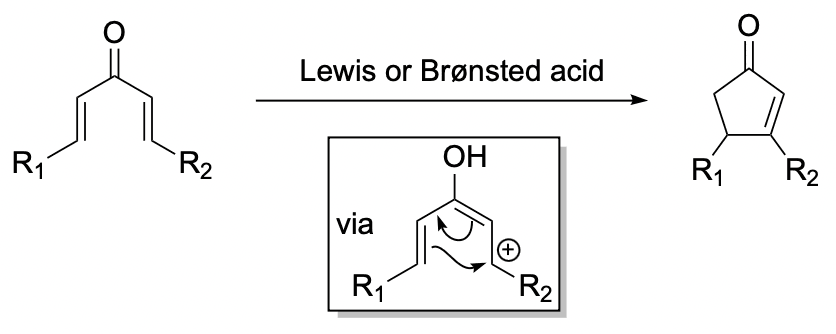The Nazarov Cyclization
Abstract
 Graphical Abstract by Amelia Campbell Mutert
Graphical Abstract by Amelia Campbell Mutert
The Nazarov cyclization is named after the eminent Russian chemist I. N. Nazarov (1900–1957). In the course of an extensive study on the formation of allyl vinyl ketones by the mercuric ion and acid-catalyzed hydration of dienynes, Nazarov and his co-workers discovered a secondary reaction to form 2-cyclopentenones. Nazarov initially formulated a direct acid-catalyzed closure of the allyl vinyl ketones and demonstrated the preparation of 2-cyclopentenones from these precursors in dozens of cases. However in 1952, Braude and Coles suggested the intermediacy of carbocations and demonstrated that the formation of 2-cyclopentenones actually proceeds via the α,α′-divinyl ketones. This fact, together with further mechanistic clarification, has led to the current formulation of the Nazarov cyclization as the acid-catalyzed closure of divinyl ketones to 2-cyclopentenones.
This process was already documented in 1903. Treatment of dibenzylideneacetone with concentrated sulfuric acid and acetic anhydride followed by mild alkaline hydrolysis afforded a ketol, the correct structure of which was finally proposed in 1955. Other examples of acid-catalyzed cyclizations of divinyl ketones exist in the early literature, as do reactions which must have proceeded via divinyl ketones.
A broader definition of the Nazarov cyclization includes a wide variety of precursors that under specific reaction conditions also produce 2-cyclopentenones via divinyl ketones or their functional equivalents. A case in point is the formation of a cyclopentenone by treatment of either divinyl ketone or tetrahydropyrone with ethanolic hydrochloric acid. It is the structural variety of precursors that lends versatility to the Nazarov cyclization and which also serves as the organizational framework for this chapter.
To facilitate presentation, the reaction is divided into six categories defined by the structure of the precursor: (1) cyclization of divinyl and allyl vinyl ketones, (2) cyclization of silylated (stannylated) divinyl ketones, (3) in situ generation/cyclization of divinyl ketones or equivalents, (4) generation/cyclization of divinyl ketone equivalents by solvolysis, (5) alkyne-based precursors of divinyl ketones, and (6) coupling reactions to form and cyclize divinyl ketones. The logic of this sequence follows from the order of decreasing structural similarity of the precursors to divinyl ketones. This is intended to be comprehensive in the coverage of cyclizations which produce 2-cyclopentenones. The related electrocyclic closure of less oxidized pentadienylic cations is not covered. The reaction was most recently reviewed in 1991. Prior to that, the Nazarov cyclization had been reviewed in 1983 and also in the context of pentannulation.

